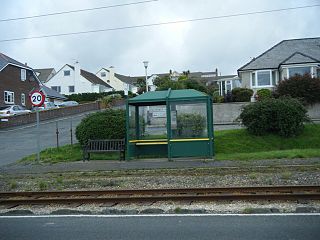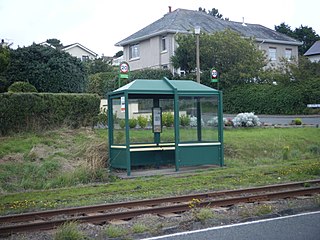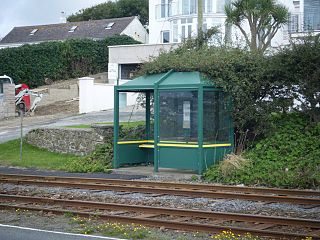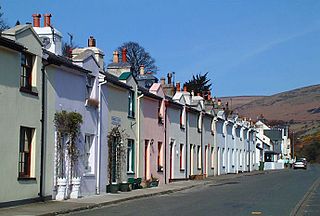
Laxey is a village on the east coast of the Isle of Man. Its name derives from the Old Norse Laxa meaning 'Salmon River'. Its key distinguishing features are its three working vintage railways and the largest working waterwheel in the world. It is also the location of King Orry's Grave.
Onchan is a village in the parish of Onchan on the Isle of Man. It is at the north end of Douglas Bay. Administratively a district, it has the second largest population of settlements on the island, after Douglas, with which it forms a conurbation.

Laxey Railway Station is an interchange station in the village of Laxey on the east coast of the Isle of Man. It is the principal intermediate station on the Manx Electric Railway as well as being the lower terminus of the Snaefell Mountain Railway. It is thus the island's only dual-gauge station, albeit with completely separate tracks. Some MER services from/to Douglas terminate here.

Onchan Head Halt was once the first official stopping place on the Manx Electric Railway on the Isle of Man and is less than one mile from the southern terminus of the line.

Bungalow Station is the only intermediate station on the Isle of Man's Snaefell Mountain Railway and is located where the main mountain road intersects the line.

Ramsey Station serves the town of Ramsey in the Isle of Man; it is the northern terminus of the Manx Electric Railway. It was formerly known as Ramsey (Plaza) Station after the nearby Plaza cinema, now demolished and turned into a car park. Today it is often also known as Ramsey Tram Station and signage to this effect adorns the station, despite the line being described as a railway. It should not be confused with Ramsey's former station on the Isle of Man Railway.
Ballabeg Station is a rural intermediate request stop on the coastal route of the Manx Electric Railway on the Isle of Man with a small station house constructed in 1905.

Garwick Glen Halt is a rural intermediate request stop on the east coast route of the Manx Electric Railway on the Isle of Man.

Groudle Glen Station is the first mandatory stopping point and major station on the Manx Electric Railway which serves the village of Groudle Glen in the Isle of Man, and is situated between Groudle Lane and Eskadale on the route to Laxey and Ramsey.

Majestic Halt is a request stop on the Manx Electric Railway on the Isle of Man and is the third stopping place on the line.

Ballaragh Halt is an intermediate stopping place on the northerly section of the Manx Electric Railway on the Isle of Man

Dhoon Glen Halt is an intermediate stopping place on the northern section of the Manx Electric Railway in the Isle of Man. It is not to be confused with Dhoon Halt, which is the next halt, about 600 metres to the north.

Ballaglass Glen Halt is an intermediate stopping place on the northerly section of the Manx Electric Railway on the Isle of Man.

Braeside Halt is a stopping place on the Manx Electric Railway on the Isle of Man and is located on the first section of the inter-urban line a short distance from its southernmost terminus.

Far End Halt is a stopping place on the Manx Electric Railway on the Isle of Man and is located on the climb towards the line's first summit.

Derby Castle Depôt is the main location of workshops and running sheds of the Manx Electric Railway on the Isle of Man and lies at the northerly end of the promenade at Douglas; it takes its name from the adjoining site which was once home to the Earls of Derby, rulers of the island, and later extended to form an entertainment complex of the same name before being demolished and replaced by the ill-fated Summerland complex in 1968.

Dumbell's Row is an intermediate stopping place on the Manx Electric Railway on the Isle of Man and is the first on the northern section of the line from Laxey, opened in 1899.
Corkill's Crossing ( is an intermediate stopping place on the northerly section of the Manx Electric Railway on the Isle of Man.

Laxey Car Shed is a storage facility for the Manx Electric Railway in the village of Laxey on the Isle of Man. It also serves as an intermediate stopping place on the line, being the last before reaching the mid-way point of the village station.
















